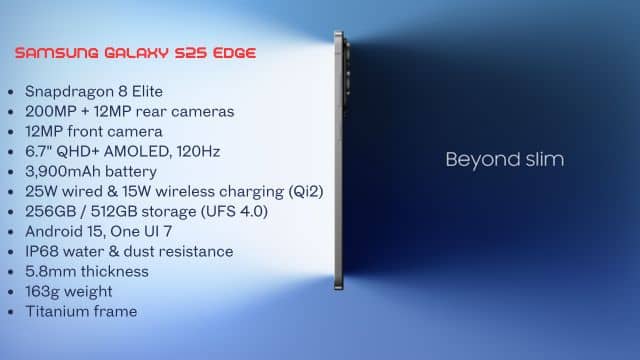The Samsung Galaxy S25 Edge has officially entered the smartphone arena, and it’s redefining what we expect from ultra-thin devices. At just 5.8mm thin, Samsung’s latest addition to the Galaxy S lineup strikes a remarkable balance between aesthetics, performance, and practicality. Featuring the cutting-edge Snapdragon 8 Elite processor, a groundbreaking 200MP camera, AI-driven capabilities, and a stunning 6.7-inch AMOLED display, this phone boldly leads the charge in 2025’s premium smartphone market.
But how does the Galaxy S25 Edge measure up against flagships like the iPhone 17 Air? Let’s take a closer look at its standout features, compare it with its competitors, and determine whether Samsung’s thinnest smartphone of 2025 is worth the hype.
Also Read : Samsung One UI 7 Update List: Eligible Devices, Features & Rollout Timeline (2025)
A Marvel of Design and Engineering

There’s no denying that the Galaxy S25 Edge is visually stunning. With a profile of just 5.8mm, it takes the title as Samsung’s thinnest smartphone yet. The titanium body adds both durability and elegance, making it as resilient as it is stylish. Weighing in at just 163 grams, this phone feels impossibly light while maintaining a premium, sturdy build.
The Corning Gorilla Glass Ceramic 2 reinforces its durability, ensuring scratch and impact resistance that is perfect for everyday use. Despite its thin design, Samsung has successfully retained a high level of functionality with the Edge’s IP68 water and dust resistance, making it a reliable companion in various environments.
How It Compares to the iPhone 17 Air
Apple’s iPhone 17 Air, with a 6.1mm thickness, is no slouch in the slim phone category. However, where the Galaxy S25 Edge edges out the competition (pun intended) is in the weight department. At 163 grams, it’s lighter than the iPhone 17 Air’s 172 grams. Additionally, the Galaxy S25 Edge offers a distinctly futuristic design with gracefully curved edges that provide a better grip compared to Apple’s more angular approach.
Key Design Highlights:
- Thickness: 5.8mm (Galaxy S25 Edge) vs. 6.1mm (iPhone 17 Air)
- Weight: 163g (Galaxy) vs. 172g (iPhone)
- Build Material: Aerospace-grade titanium with Gorilla Glass Ceramic 2
Performance Powered by the Snapdragon 8 Elite
Samsung spared no expense when it came to hardware innovation. The Galaxy S25 Edge is powered by Qualcomm’s Snapdragon 8 Elite processor, which has been specially optimized for Samsung devices. This chip not only ensures lightning-fast performance in day-to-day use but also supports advanced AI capabilities that make the phone feel highly intuitive.
Gaming and Productivity
The S25 Edge’s 12GB of RAM, paired with the Snapdragon 8 Elite, ensures seamless multitasking and gaming. Whether you’re running graphically demanding games or switching between resource-hungry apps, the phone performs without missing a beat. The revamped vapor chamber cooling system keeps the device from overheating during extended use.
When compared to the iPhone 17 Air, which features Apple’s latest A19 Bionic chip, the Snapdragon 8 Elite holds its own in terms of speed and versatility. However, where the Galaxy S25 Edge shines brighter is its compatibility with advanced AI-driven features, such as AI-powered photo editing and adaptive app suggestions.
Camera Capabilities Worth Highlighting

Perhaps one of the most impressive features of the Galaxy S25 Edge is its 200MP main camera. Built to capture every detail, this camera redefines smartphone photography, offering sharper and brighter images than its predecessors. Its standout Nightography mode works wonders in low-light environments, where other phones often falter.
Samsung’s ProVisual Engine adds vivid detail to landscapes, portraits, and macro shots, making this device a powerhouse for photographers. The 12MP ultra-wide lens, equipped with autofocus, allows users to experiment creatively with a variety of shots, from dramatic landscapes to intricate close-ups.
Comparing the Cameras
The iPhone 17 Air features a 48MP main camera and leverages Apple’s computational photography advancements. While Apple excels in color accuracy and dynamic range, Samsung’s emphasis on high resolution and clarity gives the Galaxy S25 Edge an edge, especially for professionals who prioritize detail over post-processing tricks.
Camera Features:
- Galaxy S25 Edge: 200MP Wide + 12MP Ultra-Wide with Autofocus
- iPhone 17 Air: 48MP Wide + 12MP Ultra-Wide
Immersive Display for Every Occasion
Now, what good is a smartphone without a gorgeous display? The Galaxy S25 Edge doesn’t disappoint here, thanks to its 6.7-inch QHD+ AMOLED panel. The 120Hz adaptive refresh rate smooths animations and gameplay alike, while Vision Booster technology ensures the brightest, clearest views, even under sunlight.
Samsung’s AMOLED displays have consistently outshone competitors, and this phone continues the trend. By comparison, the iPhone 17 Air offers a slightly smaller 6.6-inch Super Retina XDR display. While Apple’s display provides exceptional color accuracy, it doesn’t quite match the vibrancy and deep blacks of Samsung’s panel.
Why AMOLED Wins:
- Contrast: Deep blacks and vibrant colors
- Refresh Rate: 120Hz for smoother scrolling
- Dynamic Range: Enhanced outdoor visibility with Vision Booster
Galaxy AI Elevates Everyday Use

AI plays a pivotal role in enhancing the Galaxy S25 Edge experience. Samsung’s proprietary Galaxy AI integrates seamlessly across apps and routines. Whether you need intelligent photo editing, context-aware reminders, or personalized app suggestions, Galaxy AI is there to deliver.
The Now Brief and Now Bar features aim to streamline daily tasks, from managing emails to keeping track of appointments. Galaxy AI also works hand-in-hand with Google’s Gemini Live, allowing users to interact directly with their environment in real time using the camera.
By contrast, the iPhone 17 Air’s Siri has been shown to lag in providing the same level of AI task integration. While Apple’s ecosystem remains ahead in cross-device compatibility, Samsung’s targeted AI features outshine the iPhone’s capabilities in-app utility and multitasking.
Privacy & Security with AI
Samsung has doubled down on privacy with Samsung Knox Vault, ensuring that personal data processed by AI stays on the device. This commitment to security means your data remains yours, even while benefiting from advanced AI personalization.
Battery Life and Charging
While the Galaxy S25 Edge’s slender profile demanded certain compromises, its 3,900mAh battery still offers respectable longevity. On a full charge, the device comfortably lasts a day with moderate use. The phone supports 25W wired charging and 15W wireless charging, allowing for a quick top-up when needed. Unfortunately, its charging speeds are slower compared to the iPhone 17 Air’s 30W fast charging.
Battery enthusiasts may lean towards the iPhone 17 Air, which boasts a slightly larger 4,200mAh capacity and better-optimized software for power efficiency. However, for users who prioritize design and portability, the Galaxy S25 Edge’s battery is a worthy trade-off.
Pricing and Availability
Starting at $1,099.99 (₹1,09,999) for the base model with 256GB of storage, the Galaxy S25 Edge stands in line with premium flagship pricing. The 512GB model, priced at $1,219.99 (₹1,29,999), caters to those who need extra storage. For those looking to trade in an older device, Samsung offers generous trade-in discounts, potentially dropping the price to $469.99.
Comparatively, the iPhone 17 Air’s entry-level model retails at $1,199.99 (₹1,11,999), making Samsung’s offering slightly more accessible at its base price.
Final Verdict
The Samsung Galaxy S25 Edge isn’t just a smartphone; it’s a design statement combined with cutting-edge technology. Its ultra-thin body, powerful Snapdragon 8 Elite chip, and versatile 200MP camera make it an attractive option for anyone seeking a blend of style and performance.
While the iPhone 17 Air holds its own with premium performance and camera capabilities, the Galaxy S25 Edge delivers a more distinctive experience, particularly for users who value design and Android’s flexibility. If you’re in the market for Samsung’s thinnest smartphone in 2025, the S25 Edge sets a new benchmark.
FAQs
1. What is the thickness of the Samsung Galaxy S25 Edge?
The Galaxy S25 Edge is just 5.8mm thin, making it Samsung’s slimmest smartphone to date.
2. What camera does the Samsung Galaxy S25 Edge have?
It features a 200MP primary camera and a 12MP ultra-wide lens with autofocus, designed for pro-grade photography.
3. How does the Galaxy S25 Edge compare to the iPhone 17 Air?
The Galaxy S25 Edge is lighter, thinner, and has a higher-resolution camera, while the iPhone 17 Air offers slightly faster charging and optimized battery life.
4. What is the price of the Galaxy S25 Edge?
The base model is priced at $1,099.99 (₹1,09,999) , with the 512GB version retailing at $1,219.99 (₹1,29,999).
5. Does the Galaxy S25 Edge support wireless charging?
Yes, it supports 15W Qi2-ready wireless charging and 25W wired charging.


